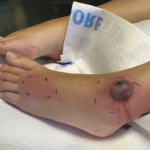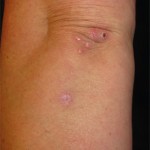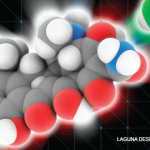C. Urticaria: The edematous nature of the Sweet’s lesion may, at times, resemble those of robust urticarial lesions; however, there are many clinical features to help distinguish these entities. The lesions of urticaria will migrate over time (excluding the case of urticarial vasculitis) with areas of clearing developing hours after mast cell degranulation has occurred locally. Symptoms such as pruritus further help to differentiate lesions. Systemic symptoms including fever do not occur in common urticaria, although they may be present in urticarial vasculitis and the urticarial eruptions of serum sickness-like reactions, potentially occurring together with arthralgias, malaise, a subtle purpuric component to lesions, and the possible finding of an active urine sediment with renal involvement. Histopathologic evaluation of skin biopsies in these entities would readily distinguish them from Sweet’s syndrome.
D. Systemic Mycoses/Deep Fungal Infections: Deep fungal infections may present as tender, scattered erythematous nodules and/or plaques. The image of these nodular lesions should invoke a differential diagnosis which includes panniculitides, including the septal panniculitis of the erythema nodosum; small–medium vessel vasculitides involving the skin, such as cutaneous polyarteritis nodosa; subcutaneous Sweet’s syndrome as described above; and infections, particularly deep fungal infections. In the proper clinical context, such as the immunocompromised individual, fungal infection should be considered and therefore a work-up including biopsy for fungal stains and culture should be performed.
E. Recurrent ANCA-vasculitis with cutaneous involvement: While recurrence of the patient’s disease could certainly present in the skin, her lesions are not typical of a small–medium vessel vasculitis. We would expect the primary lesion in that case to be nonblanching, most classically palpable purpuric lesions of small vessel vasculitis, although some morphologic variation might exist. The biopsy would demonstrate vasculitic changes (fibrinoid necrosis of the vessel wall, leukocytoclasia, extravasated red blood cells, and, in the case of granulomatous polyangiitis, a granulomatous or necrotizing component, as well) if the patient had recurrent disease involving her skin, whereas Sweet’s rarely demonstrates features of vasculitis and would have a much more dramatic neutrophilic infiltrate and papillary dermal edema.
References
- Cohen PR. Sweet’s syndrome—a comprehensive review of an acute febrile neutrophilic dermatosis. Orphanet J Rare Dis. 2007;2:34.
- Su WPD, Liu HNH. Diagnostic criteria for Sweet’s syndrome. Cutis. 1986;37:167-174.
- El-Azhary RA, Brunner KL, Gibson, LE. Sweet’s syndrome as a manifestation of azathioprine hypersensitivity. Mayo Clin Proc. 2008;83:1026-1030.
- Paoluzi OA, Crispino P, Amantea A, et al. Diffuse febrile dermatosis in a patient with active ulcerative colitis under treatment with steroids and azathioprine: A case of Sweet’s syndrome. Case report and review of the literature. Dig Liver Dis. 2004;36:361-366.
- Yiasemides E, Thom G. Azathioprine hypersensitivity presenting as a neutrophilic dermatosis in a man with ulcerative colitis. Astralas J Dermatol. 2009;50:48-51.
- Cohen PR, Kurzrock R. Sweet’s syndrome and cancer. Clin Dermatol. 1993;11:149-157.
- Walker DC, Cohen PR. Trimethoprim-sulfamethoxazole-associated acute febrile neutrophilic dermatoses: Case report and review of drug-induced Sweet’s syndrome. J Am Acad Dermatol. 1996;34:918-923.



